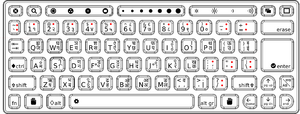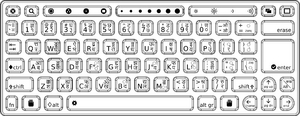Talk:OLPC Nepali Keyboard
character sample
What is the equivalent of AB (the first two letters of the alphabet) in Nepalese? --Walter 23:18, 26 September 2007 (EDT)
- It's कख Shankar 02:46, 27 September 2007 (EDT)
- Thanks Shankar. I've used them on the "language key". I've finished my first pass--any feedback would be appreciated. --Walter 13:15, 27 September 2007 (EDT)
- Purpose? If this is for something like a font sample, then you should instead use the characters which are most likely to vary in interesting ways. (for English, probably "ag") AlbertCahalan 13:11, 27 September 2007 (EDT)
Thanks Walter. In the png file that you have prepared, the fifth row (zxcvbnm -row) has some errors, could you check it once. We have some extra characters too, which we type in traditional systems using Caps Lock key. Any ideas, how can we incorporate those extra characters in this layout? -- Suyesh 08:32, 28 September 2007 (EDT)
- I'll work on the z-? row. Regarding extra characters, how many are there? We could add them as shifts to the numbers row, for example. The way the keyboard input will be set up, you can switch back and forth between Nepalese and Latin characters en mass by using the "language" key (the AB/कख) or individually by using the Alt-Gr key (for example, when in Nepalese "mode", Alt-Gr ज would give you q; Alt-Gr १ would give you 1; Shift-Alt-Gr ज would give you Q). --Walter 09:49, 28 September 2007 (EDT)
- I just posted a new version of the keyboard. Please let me know if I caught all of the changes. --Walter 10:00, 28 September 2007 (EDT)
- As per above, I'd suggest we consider any of the keycap positions marked in red for adding characters (See ). --Walter 11:35, 28 September 2007 (EDT)
- Thank you again Walter. There are about 30 extra characters but we think that some of them are obsolete. We will talk to linguist here in Nepal to decide which of them are really required, and inform you soon.--Suyesh 12:38, 28 September 2007 (EDT)
- Shankar, thanks for labeling the characters. Do you have any further word on whether or not the "extra" characters are desired or needed? -Walter 04:35, 27 October 2007 (EDT)
- Comparing with the xkb file for Nepali, there a many differences. Is there a reason for these discrepancies? --Walter 05:41, 27 October 2007 (EDT)
Nepali Unicode traditional layout
It has been suggested that we use the Unicode layout instead of a variant of the standard X Windows layout. Comments?
- Unicode layout ??? Where the suggestion came from? The layout OLPC_Nepal_Keyboard is a Unicode layout.Shankar 11:10, 12 December 2007 (EST)
- Allegedly there is a "traditional Unicode layout" for Nepal. It seems to have a number of characters that are not single unicode codes, hence, I stalled out in trying to generate the code table below. --Walter 11:17, 12 December 2007 (EST)
- The current suggestion is to use this layout (with SCIM): http://www.mpp.org.np/images/keyboard_traditional.jpg --Walter 15:19, 21 January 2008 (EST)
- Allegedly there is a "traditional Unicode layout" for Nepal. It seems to have a number of characters that are not single unicode codes, hence, I stalled out in trying to generate the code table below. --Walter 11:17, 12 December 2007 (EST)
- Nepalese government's Nepali Language Computing Team is finalizing a layout very soon. Please hold on for few weeks. This layout is not preferred by most, despite being used traditionally. -Shankar 09:02, 21 April 2008 (EDT)
Nepali "Unicode" Keyboard Layout
partial alphanumeric_keys
xkb_symbols "olpc-unicode" {
// See http://www.mpp.org.np/images/keyboard_traditional.jpg
// Contact: Walter Bender <walter@laptop.org>
include "np"
key <TLDE> { [ 0x100091E, 0x1000965 ] }; // NYA; double danda
key <AE01> { [ 0x1000967, JA_VIRAMA_NYA ] }; // Nepali digit one; U091C+U094D+U091E
key <AE02> { [ 0x1000968, 0x1000908 ] }; // Nepali digit two;
key <AE03> { [ 0x1000969, 0x1000918 ] }; // Nepali digit three;
key <AE04> { [ 0x100096A, DA_VIRAMA_DHA ] }; // Nepali digit four; U0926+U094D+U0927
key <AE05> { [ 0x100096B, 0x100091B ] }; // Nepali digit five
key <AE06> { [ 0x100096C, 0x100091F ] }; // Nepali digit six
key <AE07> { [ 0x100096D, 0x1000920 ] }; // Nepali digit seven
key <AE08> { [ 0x100096e, 0x1000921 ] }; // Nepali digit eight
key <AE09> { [ 0x100096F, 0x1000922 ] }; // Nepali digit nine
key <AE10> { [ 0x1000966, 0x1000923 ] }; // Nepali digit zero
key <AE11> { [ 0x1000913, 0x1000914 ] }; // O, AU
key <AE12> { [ 0x100200C, 0x1000902 ] }; // ZERO-WIDTH-NON-JOINER (ZWNJ); SIGN ANUSVARA
key <AC12> { [ 0x100094D, 0x100200D ] }; // SIGN VIRAMA; ZERO-WIDTH-JOINER (ZWJ)
key <AD01> { [ TA_VIRAMA_RA, TA_VIRAMA_TA ] }; // U0924+U094D+U0930; U0924+U094D+U0924
key <AD02> { [ 0x1000927, DDA_VIRAMA_DDHA ] }; // DHA; U0921+U094D+U0922
key <AD03> { [ 0x100092D, 0x1000910 ] }; // BHA, AI
key <AD04> { [ 0x100091A, DA_VIRAMA_VA ] }; // CA; U0926+U094D+U0935
key <AD05> { [ 0x1000924, E_VIRAMA_E ] }; // TA; U091F+U094D+U091F
key <AD06> { [ 0x1000925, TTHA_VIRAMA_TTHA ] }; // THA; U0920+U094D+U0920
key <AD07> { [ 0x1000917, 0x100090A ] }; // GA, UU
key <AD08> { [ 0x1000937, KA_VIRAMA_SSA ] }; // SSA; U0915+U094D+U0937
key <AD09> { [ 0x100092F, 0x1000907 ] }; // YA, I
key <AD10> { [ 0x1000909, 0x100090F ] }; // U, E
key <AD11> { [ RA_VIRAMA_ZWJ, 0x1000943 ] }; // U0928+U094D+ZWJ; VOWEL SIGN VOCALIC R
key <AD12> { [ 0x1000947, 0x1000948 ] }; // SIGN E; SIGN AI
key <AC01> { [ 0x100092C, 0x1000906 ] }; // BA, AA
key <AC02> { [ 0x1000915, NGA_VIRAMA_KA ] }; // KA; U0919+U094D+U0915
key <AC03> { [ 0x100092E, NGA_VIRAMA_GA ] }; // MA; U0919+U094D+U0917
key <AC04> { [ 0x1000901, 0x100093E ] }; // CANDRABINDU, VOWEL SIGN AA
key <AC05> { [ 0x1000928, DA_VIRAMA_DA ] }; // NA; U0926+U094D+U0926
key <AC06> { [ 0x100091C, 0x100091D ] }; // JA, JHA
key <AC07> { [ 0x1000935, 0x100094B ] }; // VA, VOWEL SIGN O
key <AC08> { [ 0x100092A, 0x100092B ] }; // PA, PHA
key <AC09> { [ 0x100093F, 0x1000940 ] }; // VOWEL SIGN I, VOWEL SIGN II
key <AC10> { [ 0x1000938, TTA_VIRAMA_TTHA ] }; // SA; U091F+U094D+U0920
key <AC11> { [ 0x1000941, 0x1000942 ] }; // VOWEL SIGN U, VOWEL SIGN UU
key <AB01> { [ 0x1000936, KA_VIRAMA_KA ] }; // SHA; U0915+U094D+U0915
key <AB02> { [ 0x1000939, HA_VIRAMA_YA ] }; // HA; U0939+U094D+U092F
key <AB03> { [ 0x1000905, U_R ] }; // A; U0909+U090B
key <AB04> { [ 0x1000916, 0x1000950 ] }; // KHA, OM
key <AB05> { [ 0x1000926, 0x100094C ] }; // DA, VOWEL SIGN AU
key <AB06> { [ 0x1000932, DA_VIRAMA_YA ] }; // LA; U0926+U094D+U092F
key <AB07> { [ 0x1000903, DDA_VIRAMA_DDA ] }; // SIGN VISARGA; U0921+U094D+U0921
key <AB08> { [ 0x100093D, 0x1000919 ] }; // SIGN AVAGRHA; NGA
key <AB09> { [ 0x1000964, SHA_VIRAMA_RA ] }; // DANDA; U0936+U094D+U0930
key <AB10> { [ 0x1000930, RA_U ] }; // RA; U0930+U0941
key <I219> { [ ISO_Next_Group, ISO_Prev_Group ] }; //language key
};
proposed addition to the Compose file
to accommodate ligatures needed for the Unicode keyboard above
# Devanagari Ligatures (used in Nepali) <U091C_U094D_U091E> : "ज्ञ" <JA_VIRAMA_NYA> : "ज्ञ" <U0926_U094D_U0927> : "द्ध" <DA_VIRAMA_DHA> : "द्ध" <U0924_U094D_U0930> : "त्र" <TA_VIRAMA_RA> : "त्र" <U0924_U094D_U0924> : "त्त" <TA_VIRAMA_TA> : "त्त" <U0921_U094D_U0922> : "ड्ढ" <DDA_VIRAMA_DDHA> : "ड्ढ" <U0926_U094D_U0935> : "द्ब" <DA_VIRAMA_VA> : "द्ब" <U091F_U094D_U091F> : "ट्ट" <E_VIRAMA_E> : "ट्ट" <U0920_U094D_U0920> : "ठ्ठ" <TTHA_VIRAMA_TTHA> : "ठ्ठ" <U0915_U094D_U0937> : "क्ष" <KA_VIRAMA_SSA> : "क्ष" <U0930_U094D_ZWJ> : "र्" <RA_VIRAMA_ZWJ> : "र्" <U0919_U094D_U0915> : "ङ्क" <NGA_VIRAMA_KA> : "ङ्क" <U0919_U094D_U0917> : "ङ्ग" <NGA_VIRAMA_GA> : "ङ्ग" <U0926_U094D_U0926> : "द्द" <DA_VIRAMA_DA> : "द्द" <U091F_U094D_U0920> : "ट्ठ" <TTA_VIRAMA_TTHA> : "ट्ठ" <U0915_U094D_U0915> : "क्क" <KA_VIRAMA_KA> : "क्क" <U0939_U094D_U092F> : "ह्य" <HA_VIRAMA_YA> : "ह्य" <U0909_U090B> : "ऋ" <U_R> : "ऋ" <U0926_U094D_U092F> : "द्य" <DA_VIRAMA_YA> : "द्य" <U0921_U094D_U0921> : "ड्ड" <DDA_VIRAMA_DDA> : "ड्ड" <U0936_U094D_U0930> : "श्र" <SHA_VIRAMA_RA> : "श्र" <U0930_U0941> : "रु" <RA_U> : "रु"

